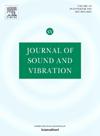Evolution of modal properties in the non-proportionally damped coupled vehicle–bridge system
IF 4.3
2区 工程技术
Q1 ACOUSTICS
引用次数: 0
Abstract
The modal properties of bridges are crucial parameters in engineering applications, and their variation caused by moving vehicles has been increasingly recognized in recent years. However, existing closed-form analytical expressions for the varying modal properties during vehicle passage exist only for simple structural configurations. This paper proposes an innovative method for analyzing the instantaneous modal properties of the system, considering general boundary conditions and the damping effect. First, only general boundary conditions are considered, and the results show that the location of the maximum system frequency shift depends on the mode shape. Then the damping effect is considered, observing that the system is non-proportionally damped in most cases, making it difficult to obtain a closed-form solution using existing methods. To solve this, we transform the system of second-order ordinary differential equations into a set of fourth-order ordinary differential equations and derive the closed-form solution for system’s modal properties. Based on this solution, we introduce the concept of Critical Coupling Damping (CCD), which defines the transition between the coupled description and the moving mass case. This work deepens understanding of changing modal properties during the traverse of sprung masses, and so has numerous potential engineering applications.
非比例阻尼耦合车桥系统的模态特性演变
桥梁的模态特性是工程应用中的关键参数,近年来,人们越来越认识到移动车辆对其造成的影响。然而,现有的车辆通过时模态特性变化的闭式分析表达式仅适用于简单的结构配置。本文提出了一种分析系统瞬时模态特性的创新方法,同时考虑了一般边界条件和阻尼效应。首先,只考虑一般边界条件,结果表明系统最大频移的位置取决于模态形状。然后考虑阻尼效应,观察到系统在大多数情况下是非比例阻尼的,这使得使用现有方法难以获得闭式解。为了解决这个问题,我们将二阶常微分方程系统转化为一组四阶常微分方程,并推导出系统模态特性的闭式解。在此解的基础上,我们引入了临界耦合阻尼(CCD)的概念,它定义了耦合描述和移动质量情况之间的过渡。这项研究加深了人们对弹簧质量移动过程中模态特性变化的理解,因此在工程应用中具有巨大潜力。
本文章由计算机程序翻译,如有差异,请以英文原文为准。
求助全文
约1分钟内获得全文
求助全文
来源期刊

Journal of Sound and Vibration
工程技术-工程:机械
CiteScore
9.10
自引率
10.60%
发文量
551
审稿时长
69 days
期刊介绍:
The Journal of Sound and Vibration (JSV) is an independent journal devoted to the prompt publication of original papers, both theoretical and experimental, that provide new information on any aspect of sound or vibration. There is an emphasis on fundamental work that has potential for practical application.
JSV was founded and operates on the premise that the subject of sound and vibration requires a journal that publishes papers of a high technical standard across the various subdisciplines, thus facilitating awareness of techniques and discoveries in one area that may be applicable in others.
 求助内容:
求助内容: 应助结果提醒方式:
应助结果提醒方式:


